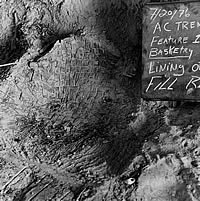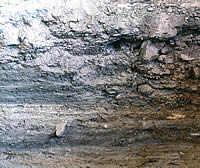Cultural Features
Many cultural features were recognized at Hinds Cave, so many that the archeologists faced a quandary seldom encountered in “ordinary” open campsites. During excavations at most open prehistoric campsites in Texas, cultural features—clusters of artifacts and discrete localized patterns thought to represent distinct behavioral events or activities—are relatively uncommon and fairly easy to record. But at Hinds Cave, excavators encountered literally hundreds of discrete patterns that might be considered special features at an ordinary site. Most of these were designated as lenses rather than features, per se. Still, some patterns stand out as being particularly noteworthy. While no master list of the features and separate lenses exists, examples of some of the remarkable cultural features are mentioned here.
Prickly Pear Floors
In Area A and the A-C Trench, several distinct fiber lenses were documented that contained a great many prickly pear pads. Although most of the pads were fragmented and crushed, several intact-looking areas were uncovered that had whole pads lying flat and overlapping with one another. Upon careful examination, it could be seen that most of the thorns had been singed off of the pads. Shafer interprets these layers as purposeful floor coverings that he thinks were intended to hold down cave dust and make the shelter more livable.
It seems reasonable to guess that the pads may have been originally used as layers of green “packing” material in the earth ovens that often built within Hinds Cave to bake lechuguilla and sotol. In an earth oven, the plants are baked with steam generated by a layer of green plant material placed between the heated stones and the food (sotol and lechuguilla leaf bases or hearts). Prickly pear pads are an ideal packing material and are one of the few moisture-laden plants available in the drier and cooler months of the year. Experimental work has shown that using prickly pear pads in this way removes most of the thorns by singing. Dozens of dried-out and more or less thorn-free pads are generated as debris during each major baking episode. We can speculate that the used earth oven packing material may have been reused to line the dusty floor of the living areas of Hinds Cave.
Sleeping Beds
A series of relatively small, circular to oval grass- and fiber-filled pits were uncovered at Hinds Cave that are thought to represent sleeping beds. These "grass beds" were mainly found in the main living area of the shelter, especially along the rear wall. Worn plaited mat fragments, discarded sandals, and various other plant remains were found within these pits. It is inferred that, when the beds were in use, intact mats would have been added as a final layer, making a comfortable padded sleeping nest. From the size and configuration of these pits, it is obvious that those sleeping in the beds must have preferred the fetal position.
Burned Rock Middens (Earth Oven Facilities)
Layers of fire-cracked limestone (burned rock) were quite common within the Hinds Cave deposits; some layers were thin, some appeared to line pits, some were mixed with fiber debris, and some were quite thick and composed mainly of fist-sized fragmented rocks amid ashy, carbon-stained soil. The thickest and most concentrated lenses are the equivalent of the burned rock middens that occur in literally thousands of campsites across the Lower Pecos Canyonlands and the Edwards Plateau. As is now well established, burned rock midden deposits mark earth oven facilities.
The largest and most obvious burned rock midden encountered at Hinds Cave lay buried beneath a thick fiber layer that had been badly disturbed by collectors in the central part of the shelter. The A-C Trench profile provided a good exposure of this feature which was later assigned to AU 6. Three radiocarbon assays suggest that this accumulation of spent cooking stones formed around 5100-5500 B.C. during the latter part of the Early Archaic. At the time of the field investigations, archeologists did not yet fully understand how burned rock middens formed. Based on what we know today, we would predict that the observed rocks were discarded cooking stones that were ejected from a central baking pit (earth oven facility) that probably lay between excavation areas.
A second midden is represented by the apparent "sotol pit" visible on the surface of the northern part of the cave. The Area F excavations encountered a thick refuse deposit containing many cut sotol and lechuguilla leaf bases, quids (chewed leaf bases), and burned rocks. These are thought to represent debris associated with the "sotol pit" midden or other undetected earth oven facilities in the north end of the shelter. Based on a single radiocarbon date, midden accumulation in this area dates to the Late Archaic (calibrated midpoint, A.D. 205).
Latrines
Among the most unusual and fascinating features at Hinds Cave were lenses containing coprolites and associated areas apparently used as designated latrines. In general, the latrine areas occurred in Areas B and C off the edge of the flat rear section of the cave where sleeping beds were concentrated. In other words, the latrines were located on the sloping surface of the "outer" cave, an area also used as a toss zone for refuse.
Most of the latrines in Area C seem to be relatively thin layers of coprolites representing latrines used for relatively short periods of time. Area B proved, however, to contain a special area of the cave that was used as a latrine over and over again, probably for thousands of years. The Area B deposits yielded hundreds of coprolites, some in thick layers. In the lower deposits in Area B, thin, superimposed, micro-lenses of urine-compacted soil were exposed and clearly visible in the profile.







